|

News Brief Archives
|
|
News Briefs Archives
March 20 - June 18, 2005 |
|
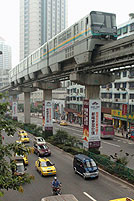
|
|
Chongqing Monorail opens!
(6/18/05)
Chongqing, China. Today marks the first official
day of the Chongqing Monorail. The 13.5-km system opened today
with a ceremony that included attending officials from Japan
and China. The Chongqing Monorail is the first to open outside
Japan with Hitachi monorail technology. The project was largely
funded by Japanese loans. Satoshi Iwamura, Japan's vice-minister
for land, infrastructure and transport, said in a speech, "We
hope that this facility will be used and loved by Chinese citizens
for long and will become a bridge nurturing friendly ties between
Japan and China." Chongqing Mayor Wang Hongju said
at the ceremony, "The monorail provides a range of advantages
in that it does not produce much noise and does not take up much
land. In addition, it helps ease traffic congestion." The
monorail is capable of transporting 200 million passengers annually,
and extensions are already in planning stages. The system was
built and completed in less than five years, despite enormous
challenges along the route. There is a 2.2-km subway section
that the monorail negotiates through, as well as giving passengers
spectacular hillside views of a nearby river. The Monorail Society
congratulates Chongqing and Hitachi on this momentous achievement!
Japan-funded
monorail opens in Chongqing. MC website, 6/18/05.
Chongqing Monorail website
(in Chinese and sometimes loads very slowly)
|
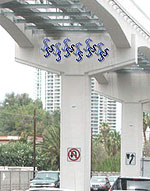 |
|
Las Vegas Monorail-what
the media isn't saying (6/16/05)
Las Vegas, Nevada. Despite media attention given
to every little glitch that the Las Vegas Monorail (LVM) has
suffered, the president of the company that led to the development
of the system says there is a lot of good news not being reported.
Tom Stone, President of Transmax Group LLC, shared some
interesting data recently with an online Seattle Monorail discussion
group. Since the system's reopening in December, ridership and
revenue have been growing steadily. Stone states "Average
revenues now are over $100,000 per day, which is more than debt
service requirements for the bonds. With just over a four-mile
system, average daily ridership is over 30,000 per day, with
many days nearing 50,000, which I believe already is far more
than the initial ridership of any of the nation's new-start light
rail systems over the past 20 years." Not only that, but
upcoming efforts by LVM should increase ridership with links
to pre-ticketing for the conventions, links to resort guest portfolios,
and improved paths to monorail stations. Despite troublesome
closures during its debut year of 2004, the monorail is now operating
consistently at over 99% reliability. Stone says, "This
is a reliability level that is higher even than most airport
people movers, an unprecedented accomplishment for an automated
urban transit system." Transmax is also responsible for
the advertising and corporate sponsorship program for LVM, which
has contracted more than $100 million in revenues. Efforts are
also under way to extend the monorail without the use of federal
funds. Stone hopes to have good news on this within the next
few months, but won't go public until it's a "done deal." |
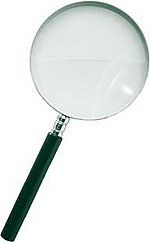 |
|
SMP readies for intense scrutiny
(6/13/05)
Seattle, Washington. The Seattle Popular Monorail
Authority (SPMA) is readying for an onslaught of scrutiny as
it prepares to release details of its recent completed contract
negotiation with Cascadia Monorail Company. The release of the
contract may come next week, with pages and pages of details
for monorail supporters, interested citizens and critics to dig
through. To get a good deal for Seattle, negotiations were held
in confidentiality. As if the scrutiny of the public and critics
isn't enough, the SPMA is also about to go through its annual
audit. Washington State Auditor Brian Sonntag sent a letter
to the agency expressing "our concerns and those of others
about the viability of the Seattle Monorail Project, particularly
the ability to finance it and meet projected costs." Sonntag
cited concerns of State Treasurer Mike Murphy who is "deeply
concerned about overly optimistic revenue projections, about
the aggressive project scope, about what they believe has been
a lack of openness, and about the potential effect of the project
on taxpayers not just in Seattle, but throughout the state."
How the SPMA fares in the coming months will result in Seattle
citizens finally getting construction started of their long-awaited
and voted-for monorail system...or not.
Seattle
Monorail: Little train that can? Seattle P-I, 6/5/05.
$2.1 Billion Monorail. Seattle Weekly, 6/8/05.
Seattle Monorail: Eyeballing the deal. Seattle P-I, 6/13/05.
Seattle Monorail Project website
Cascadia Monorail
website
Hitachi
Monorail website
|
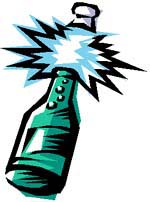 |
|
SMP/Cascadia agreement in
Seattle (6/3/05)
Seattle, Washington. The Seattle Monorail Project
(SMP) has reached an agreement in principle with Cascadia Monorail
to build a 14-mile monorail line. According to an SMP press release
today, both sides are now reviewing and conforming the contracts
and six volumes of documents, a process that is expected to take
about two weeks. "The people of Seattle have made it clear
they want the Monorail. They want the Monorail for its environmental
benefits and for the ability to get around town without a car.
It's especially important to have the Monorail running while
the Viaduct is shut down," said Joel Horn, SMP executive
director. "This has been a gargantuan effort. We are exhausted,
but really proud that in just a couple of weeks we'll have final
contracts to recommend to the Board." According to a press
release from Fluor Corporation, the Green Line is currently the
United State's largest rail contract. Per SMP, major elements
of the Seattle Monorail Project Green Line agreement include:
- The entire 14-mile, elevated Monorail will be built along
the voter-approved Green Line route for a fixed price of slightly
over $1.6 billion which (along with funds for utilities,
improvements, oversight and any contingencies) fits within the
voter-mandated funding limits.
- Automated walk-through trains will arrive every eight minutes
to accommodate expected ridership on opening day; as ridership
grows, trains can be added to run every three minutes downtown
and every six minutes in West Seattle and Ballard.
- Riders will be able to access the Green Line from 17 stations
16 of which are included in the fixed price contracts,
with the 17th to be constructed as soon as the property for the
station at 2nd & Madison (now occupied by the Federal Reserve
Bank) is available for purchase by SMP. Up to three more stations
can be added at 35th & Avalon, Elliott & Mercer and Blaine
& 15th.
- SMP's strong commitment to environmental sustainability will
be incorporated throughout the contracts, including trains with
regenerative braking to conserve energy, minimizing energy use
in both construction and operation of the stations, and allowing
bicycles on trains.
- Monorail stations will be convenient to buses, light rail,
ferries and other types of mass transit, allowing for travel
throughout Puget Sound.
- Monorail riders will be able to use the Smart Card, a single
access fare card being developed for use by passengers on any
type of transit throughout Puget Sound.
- The Monorail is scheduled to open on December 1, 2010, providing
needed relief for Seattle residents and visitors when the Viaduct
is closed for repair or reconstruction.
Monorail
agency reaches deal with agency. Seattle P-I, 6/3/05.
Fluor
Corporation press release: Nation's Largest Rail Contract
Monorail
agreement reached. Seattle Times, 6/3/05.
Seattle
Monorail: Little train that can? Seattle P-I, 6/3/05 (posted
6/3/05).
Seattle
Monorail reaches agreement with contractor. Pugent Sound
Business Journal, 6/3/05.
Seattle Monorail Project website
Cascadia Monorail
website
Hitachi
Monorail website
|
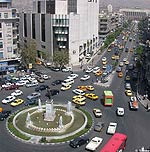 |
|
MTrans wins big in Syria (6/2/05)
Damascus, Syria. Syria's Minister of Transport,
Makram Obeid, says that MTrans of Malaysia has been selected
to build an extensive monorail system in the Syrian capital of
Damascus. Monorail has been being selected for several reasons,
one of which is the quickness in which a system can be implemented.
Another reason is the comparative low cost of building monorail
as opposed to other more traditional rail systems such as subway.
The plan for Damascus includes three different lines, each differentiated
by color; a 16-km Green Line from Mazzeh to Qaboun, a 11-km Red
Line from Barzeh to Midan, and a 8-km Blue Line from Abbasid
Square to Abdel Rahman al-Dakhel Square. Lines would be built
in different construction phases. The Blue Line would be the
first and would open within two years. If built to completion,
the three lines would include a total of 46 stations, more than
any other monorail system in the world. MTrans estimates that
the estimated cost for the Damascus Monorail is $16 million per
kilometer (USD). The Syrian government will finance the civil
works, while engineering, supply of trains and other items will
be financed through a Build-Operate-Transfer process (BOT). Damascus
has an estimated population of over three million people.
Damascus Monorail
on track. AME Info, 6/2/05.
|
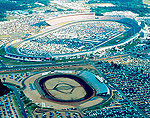 |
|
Speedway owner seeks monorail
(5/24/05)
Concord, North Carolina. O. Bruton Smith, founder
and chairman of Lowe's Motor Speedway, is pledging $50 million
of his personal funds to jumpstart a peoplemover system. Smith's
concept is for a "monorail-style" transport along state-owned
roads to connect a proposed NASCAR Hall of Fame to University
City, Lowe's Motor Speedway and Concord Mills. The monorail system
would run from the NASCAR Hall of Fame up North Tryon Street
through UNC-Charlotte and University City along U.S. Highway
29 to the speedway and across Speedway Blvd. to Concord Mills.
He believes that an elevated rail would be more efficient than
the proposed Northeast Corridor Light Rail Project (slated for
completion around 2018). He also states that it could be built
and opened to the public much faster. "The future can be
now," Smith said. "With the NASCAR Hall of Fame proposal
due at the end of the month, how powerful of a message could
we send by including this concept? This month, we are hosting
more than 400,000 race fans from 50 states and 12 foreign countries.
With this system in place, race fans could ride the monorail
from the speedway down to the NASCAR Hall of Fame, visit Food
Lion Speed Street and return without turning a wheel." No
specific technology has been selected at this point.
Smith
pledges $50 million to jumpstart monorail project. That's
Racin website, 5/24/05.
|
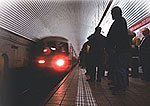 |
|
Subway may compete
with Las Vegas Monorail (5/22/05)
Las Vegas, Nevada. MGM Mirage is partnering with
Jakes Associates, Inc. of San Jose, California, to provide a
rubber-tired subway system for the west side of the Las Vegas
Strip. Ironically, this same partnership helped produce the first
leg of the Las Vegas Monorail in the 1990s. Now MGM Mirage is
developing a massive project betweeen Monte Carlo and Bellagio
called CityCenter. The multi-billion dollar city within a city
will include hotels, casinos, retail and residential space. Construction
for CityCenter will begin within two years. The subway system
will be reportedly built economically "by reducing the tunnel
cross-section by at least 40% compared to conventional subway
systems without any compromise to system capacity." When
completed, the integrated system will provide full transit service
to the west side of the Strip. In a Jakes press release, the
company states "as it will likely be free of charge, the
system will certainly challenge the current monorail system on
the opposite side of the Strip, which is quite expensive to use
and inconveniently located away from destinations directly on
the Strip." Interesting language, considering the monorail's
development was started by MGM and currently serves MGM at the
south end of the line. This news comes at a time when the Regional
Transportation Commission is severing ties with Las Vegas Monorail
to build an extension to downtown, due to lack of Federal dollars
for the project. The subway project puts pressure on the monorail
to extend, either to the airport or downtown, in order to provide
service that the subway won't. How it will compete with a free-ride
system on the Strip remains to be seen. |
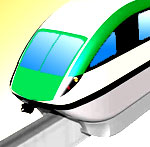 |
|
Cascadia 28-member team qualified
(5/9/05)
Seattle, Washington. The Seattle Monorail Project
(SMP) has qualified the 28-member Cascadia Monorail Company to
continue negotiating for the 14-mile Green Line monorail system.
The team has been restructured since Washington Group International
(WGI) dropped out, citing excessive project risks as their reason.
Fluor Corporation of Irvine, California is now the largest partner
in the team, which will use Hitachi monorail technology for the
Seattle system. Fluor will now supply new project managers that
originally would have been staffed by WGI. The SMP and Cascadia
are in the final stage of negotiation and are expected to reach
a proposed final agreement by June or July. Contracts will then
be made available to the public and the SMP Board will decide
whether to approve the contracts. If approval is made, Cascadia
Monorail Company will complete the design, then construct, operate
and maintain the monorail system.
Cascadia
OK'd to move ahead on monorail. Seattle P-I, 5/12/05.
|
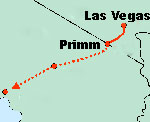 |
|
Nevada maglev back in the
race (5/9/05)
Las Vegas, Nevada. The proposal for a Transrapid
maglev demonstration line through the desert may be back on the
table, if the California-Nevada Super Speed Train Commission
has its way. If funds are approved, a government/industry partnership
would build a $1.3 billion line between Las Vegas and Primm,
Nevada. But first, the proposal must beat out two other maglev
proposals on the east coast. One is for an airport connector
in Pittsburgh, Pennsylvania and the other is for Baltimore to
Washington D.C. The Las Vegas-Primm proposal was eliminated from
the competition for government funding during the Clinton administration,
but efforts by Rep. Don Young (R-Alaska), the chairman of the
House transportation committee and Senate Minority Leader Harry
Reid (D-Nevada) have brought Nevada back into the game. The Las
Vegas-Primm alignment is primarily through desert terrain, as
opposed to the eastern proposals, which are plagued with many
complaints by NIMBYs (Not In My Back Yard). The commission sees
the 40-mile Primm line as a starter for a proposed 270-mile Las
Vegas to Anaheim maglev system. Congress will decide which of
the three projects will be funded with $950 million and that
decision may be soon. The maglev is part of the transportation
bill that is now in the Senate, which has already passed the
House.
High-Speed
Train Plan May Move Forward. KTLA, 5/9/05.
Baltimore Washington
Maglev
California-Nevada
Maglev
Pennsylvania Maglev
Transrapid USA website
|
 |
|
USA press coverage of Las
Vegas mishaps (5/8/05)
Las Vegas, Nevada. Automobile accidents are responsible
for a staggering 40,000 deaths each year in the USA alone. Elsewhere
in the world, auto death statistics are even more staggering,
yet judging by press coverage, you would think that monorail
is one of the most hazardous forms of transit. Unfortunately,
Las Vegas Monorail suffered two more brief shutdowns last week.
Press stories from Las Vegas on the incidents were quickly picked
up and reported by press outlets all around the world. It seems
that if you operate a monorail, you will get more coverage when
things go wrong, no matter how minor the problem may be. If you
have light rail, the scrutiny isn't anywhere near as close. Light
rail, which has accidents with vehicles and pedestrians on a
regular basis, resulting in tragic injuries and death, more often
gets a pass. That pass even includes coverage from their local
press establishments. That said, the problems of Las Vegas Monorail
are not helping promoters support claims of monorail's reliability.
Passengers were stranded on the "Only Vegas" train,
two days in a row on separate occasions when a communications
problem interrupted service. When problems occur with the automated
Bombardier-built and operated monorail, trains are supposed to
return passengers to the nearest station. The malfunctioning
train stopped on the guideway and didn't return to the station.
According to media reports, interior temperatures climbed quickly
and passengers contemplated breaking windows just before firefighters
opened doors. Las Vegas Monorail officials and Bombardier are
working to quickly fix the glitch. The system is currently operating
on its regular schedule of 7 AM to 2 AM.
The
little train that couldn't. Las Vegas Sun, 5/4/05. Does the
press write commentary like this on accident-prone light rail
systems in Houston, San Jose, Salt Lake City, Dallas, San Francisco,
Portland, Tacoma, Dallas, and elsewhere? How about in cities
planning or building light rail?
Temperatures rise inside a trapped Las Vegas Monorail car.
KVBC TV, 5/3/05.
Second
malfunction in two days strands riders on Las Vegas Monorail.
Las Vegas Sun, 5/3/05 (picked up by Associated Press and reported
extensively around the world).
Las Vegas Monorail Opening-TMS exclusive
photo essay from July 14, 2004, includes images of "Only
Vegas" train.
|
|
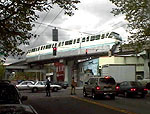
photo courtesy of Glenn Barney
|
|
Seattle Blue
is back! (5/8/05)
Seattle, Washington. After eleven months of meticulous
restoration, Monorail Blue has returned to service on the historic
mile-long Seattle Center Monorail. The Alweg-built Monorail Blue
suffered serious damage on May 31, 2004 when fire broke out below
the 1960's-vintage vehicles' floor. Monorail Red's side-by-side
ramp and fire truck ladders were used to evacuate the train.
Repairs included modifying the trains' electrical systems to
eliminate the possibility for the type of electrical arcing that
caused the fire. A "hot body" detector and new grounding
system were installed; train floors and walls are now made fire-resistant
enough to allow safe evacuation; and train gearboxes are insulated.
The monorail is slated for removal if the 14-mile Seattle Monorail
Project Green Line monorail is constructed. Preservationists
are hoping that the Alweg trains are saved for display or possibly
put into service at another location. The Seattle Center Monorail
carries more than 2 million riders annually. Businesses at both
ends of the line noticed around 30% drop in sales when the line
closed after the fire. Monorail Red returned to service late
last year after similar safety modifications. |
 |
|
Familiar debate
in Bangalore (4/28/05)
Bangalore, India. An all too familiar debate is
taking place in Bangalore, India. Metrail Private Limited argued
for monorails at a meeting with the Karnataka State Pollution
Control Board (KSPCB) recently. As a result, KSPCB chairman Bhoomanand
Manay submitted a report to the government suggesting Metrail's
monorail as the best option for rail transit in the city. On
the other hand, Bangalore Mass Rapid Transport Limited (BMRTL)
believes that heavy rail metro is the best option. MPL director
Rehan Khan recently said ''the taxpayers of this city
do not have to churn out their money for the monorail. For the
metro they would be paying very dearly for a system that does
not cover the city entirely. We are privately aided and we will
recover our money if allowed to operate in the city for 30 years.
After which it is deemed public property.''
Green
board shows red to metro project. Newindpress.com, 4/28/05. |
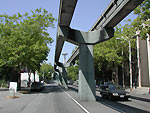 |
|
WGI drops out of Seattle project
(4/28/05)
Seattle, Washington. Negotiations are in their
final stages between Seattle Monorail Project (SMP) and the Cascadia
Monorail Company, but Cascadia has lost one its major partners.
Washington Group International (WGI) has pulled out for "business
reasons," concerned that the risks of the project are too
high. WGI has already invested $5 million and spent four years
on the project. WGI is a large civil construction firm and would
most likely have been in charge of track and structure construction.
Cascadia has 28 other companies in the team. Fluor Enterprises
is another lead partner and will likely take over WGI's responsibilities.
Before a meeting of monorail board members, SMP director Joel
Horn stated that he's "99.8 percent, 99.9 percent"
sure that a deal can still be forged with Cascadia.
Major
monorail partner pulls out of project. Seattle Times, 4/28/05,
Seattle Monorail Project website
Cascadia Monorail
Team
|
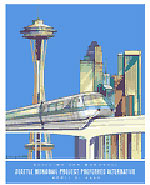 |
|
"Major step forward:
in Seattle (4/6/05)
Seattle, Washington. The Seattle Monorail Project
(SMP) has taken a "major step forward," according to
SMP Executive Director Joel Horn. At tonight's Seattle
Monorail Board of Director's meeting, Horn announced that the
Cascadia Team submitted a refined bonded proposal last Thursday.
The new proposal is the result of the last eight months of negotiations
with the SMP. The project now moves into the final negotiation
stage, which SMP staff members said could take 60-90 days, or
possibly more if difficulties arise. After the announcement,
Board member Cleve Stockmeyer said that "it sounds
like we're on track to do what the public has asked us to do."
He went on to say "this is very reassuring to me."
Most board members made optimistic statements as a result of
the good news and no longer believe a negotiation deadline is
necessary. The next 60-90 day period will include a staff review
of the refined proposal and a pricing review. If all goes well,
a final price will be negotiated in May/June. At the end of Horn's
presentation a computer simulation video of Hitachi two-car trains
quietly cruising through Seattle Center was shown.
Seattle Monorail Project website
Cascadia Monorail
Team
|
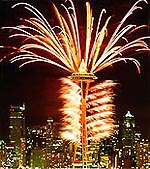 |
|
Seattle monorail opponents
lose another one (4/4/05)
Seattle, Washington. Monorail opponents continue
to throw their money into efforts to derail the Seattle Monorail
Project (SMP). Ignoring the fact that Seattle voters have voted
for the monorail on several occasions, opponents have tried several
tactics to stop the monorail from being built. The latest effort
was via a lawsuit, claiming that the auto tax that funds the
monorail is illegal. Today Judge William Downing dismissed
their claims. The lawsuit was filed by eight Seattle vehicle
owners, with a legal team including Henry Aronson, a longtime
monorail foe. SMP spokeswoman Natasha Jones said, "The
judge couldn't have been more clear in dismissing the claims,
I think it just really helps us." An appeal is expected.
On Wednesday night, monorail board members will consider a deadline
for negotiations, which have been under way since last year.
Court
upholds monorail tax. Seattle Times, 4/4/05.
Seattle Monorail Project website
|
 |
|
Las Vegas Monorail: bad/good
news (3/31/05)
Las Vegas. Nevada. Moody's Investors Service dropped
$455 million in Las Vegas Monorail bonds to "speculative"
grade, also known as junk bond status. Lagging ridership and
revenues were sited as concerns that led to the downgrade. Despite
the apparent bad news, Anne Van Praagh, a Moody's analyst,
stated, "Long-term, we do think that this project has a
lot of potential." The downgrade will have no effect on
the monorail's day-to-day operations, as the bonds are insured
against default. Monorail spokesman Todd Walker said,
"This doesn't have any short-term effect on the project
whatsoever. It has no impact on the state. It does not impact
on the taxpayer." Still, the impact may be to force the
monorail to pay higher interest rates to raise more cash for
expansion. Moody's report indicates that the system needs an
increase in ridership and revenues in order to achieve financial
self-sufficiency. "While the ramp-up period ridership through
the first quarter of 2005 has shown positive growth, more operating
history will be needed to fully assess credit quality,"
Moody's said. Despite numerous system shut downs from technical
problems last year, the system has operated almost perfectly
since December 24th. Monorail officials remain optimistic that
ridership numbers will increase throughout 2005. Walker said
to the Las Vegas Review-Journal "I think the numbers will
show a dramatic increase in March ridership and revenue over
February." Farebox revenues were over $150,000 on March
15, and 48,000 people used the system on March 16.
Monorail's
bonds fall to 'junk' status. Las Vegas Review-Journal, 3/31/05.
Monorail
firm's rating lowered. Las Vegas Sun, 3/31/05.
|
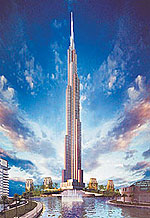 |
|
Dubai peoplemover monorail
proposed (3/30/05)
Dubai, United Arab Emirates. A new district in
the City of Dubai is being developed, the Burj Dubai district.
It will be an area of superlatives, with the world's tallest
skyscraper and the world's largest mall. Developers expect 40
million people to visit the mall each year. 100,000 people will
live in Burj Dubai. A 1.3 km monorail is being considered to
shuttle people around the area. It would connect the Dubai Mall
to the new Dubai light rail system. Burj Dubai is scheduled for
completion by 2009. The monorail project would be acquired via
competitive bidding by Emaar Properties, the Burj Dubai developer.
If developed, the Burj Dubai Monorail will be the second in U.A.E.,
following another new monorail to be built on the Palm Jumaeirah
man-made island project.
Burj Dubai website
|
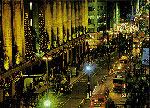 |
|
Oxford Street proposal, London
(3/30/05)
London, England. A monorail is being proposed to
help solve gridlock on Oxford Street. The proposal has the backing
of Lord Rogers, the Mayor's leading architectural adviser.
Rogers says the monorail would help create a more "civilized"
environment and allow Oxford Street to compete with large shopping
centers outside of London. Ian Wilder, a Westminster councilor,
conceived the monorail to run the mile-length of the street and
link it with Piccadilly Circus. The monorail would also serve
a new convention center. Wilder points out that monorail is easier
to build than a street tram system, which would require underground
utilities and water mains to be moved at great expense. "The
monorail is also a lot cheaper than a tram. It doesn't rule out
doing other things and having vehicles underneath such as taxis,"
said Wilder.
Monorail
for Oxford Street? This is London website, 3/30/05.
|
 |
|
Kitakyushu Monorail operating
after earthquake (3/20/05)
Kitakyushu, Japan. A 7.0 magnitude earthquake shook
the island of Kyushu on Saturday, killing one and injuring over
500 citizens. The quake's epicenter was west of Kyushu and approximately
nine kilometers beneath the ocean floor. Hundreds of homes were
damaged or destroyed in Genkaijima island, Fukuoka Prefecture
and Nagasaki Prefecture. All rail services made emergency stops,
including eight Shinkansen high-speed rail trains. Kitakyushu
Monorail also came to a halt when the earthquake struck at 10:53
AM. The earthquake magnitude was 4.0 in the monorail area. After
inspection of the system, monorail service resumed at 2 PM, only
three hours later. The Kitakyushu Monorail opened in 1985 and
features the first all-flat floor monorail trains from Hitachi.
No passengers were hurt during the earthquake. The 8.8 kilometer
system includes concrete beams for most of the alignment, while
steel track is used for longer spans. One portion of the guideway
is attached to the supports of an automobile expressway that
runs above the monorail.
Kitakyushu
Monorail website
Monorails of Japan DVD (features
a segment on Kitakyushu Monorail)
|
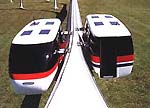 |
|
Futrex tries again (3/20/05)
Charleston, North Carolina. The promoters of Futrex,
the monobeam system in which trains share one beam for bi-directional
travel, are trying again to get a full-scale demonstration line
build. A proposed $35 million line between Charleston International
Airport and Charleston Convention Center came up short in funding.
$6.2 million was appropriated to the project by Congress from
1998 through 2000. Most of that money remains unspent, and Futrex
would like to modify their proposal to a shorter demonstrator
line. The company has submitted a plan to the Federal Transit
Administration (FTA) seeking to use the money for a prototype
at the former Navy Base costing approximately $15 million. The
FTA would have to approve the change, because the $6 million
was earmarked for a prototype to serve the airport. Futrex is
attempting to attract private financing for the balance of the
project's cost.
Monorail
company scales back plans. The State, 3/20/05
Futrex website
|
| |
|
 / News
Briefs Archives / News
Briefs Archives |



















